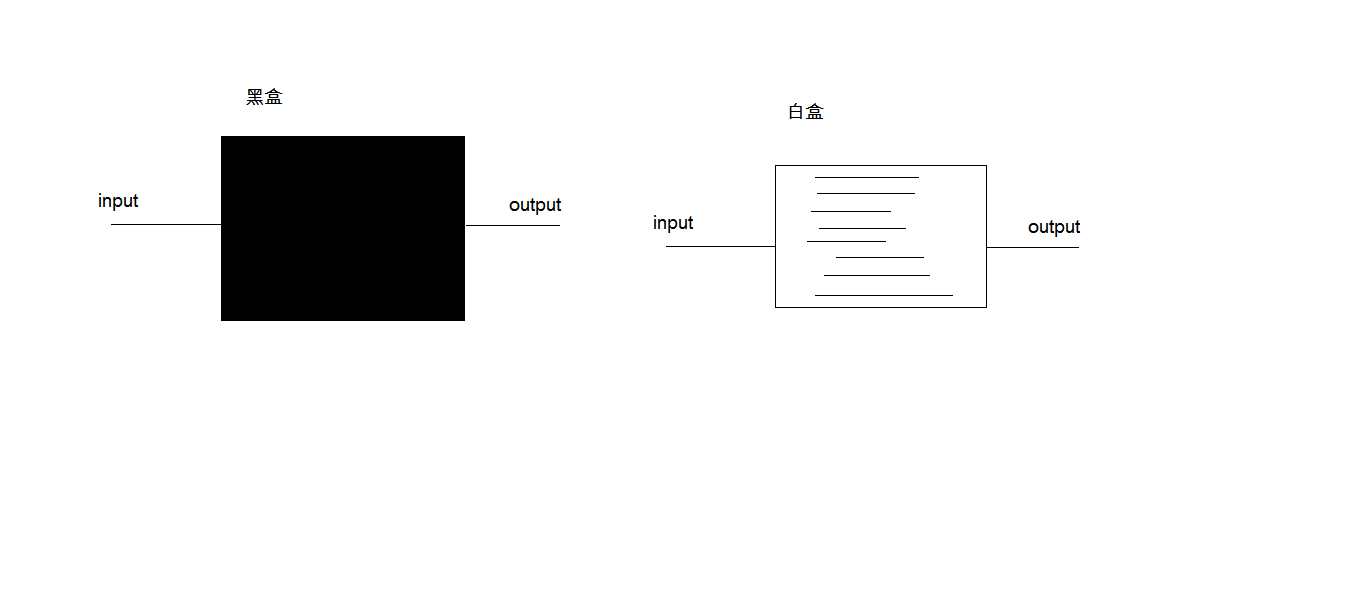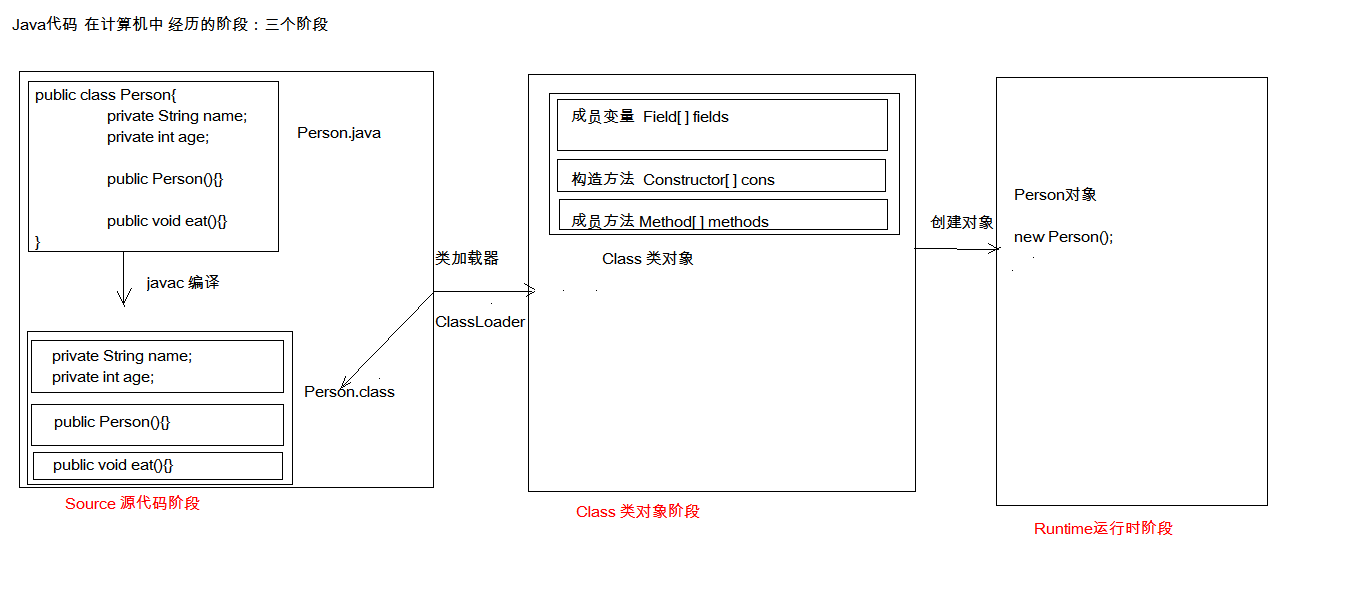今日内容 1. Junit单元测试
2. 反射
3. 注解Junit单元测试: 测试分类:
Junit使用:白盒测试
步骤:
定义一个测试类(测试用例,建议命名)
测试类名:被测试的类名+Test e.g. CalculatorTest
包名:xxx.xxx.xx.test cn.itcast.test
定义测试方法:可以独立运行(建议)
方法名:test测试的方法名 testAdd()
返回值:void
参数列表:空参
给方法加@Test
导入junit依赖环境
判定结果:
红色:失败
绿色:成功
一般我们会使用断言操作来处理结果
Assert.assertEquals(期望的结果,运算的结果);
1 2 3 4 5 6 7 8 9 10 11 12 13 14 15 16 17 18 19 20 21 22 23 24 25 26 27 28 29 30 31 32 33 34 35 36 37 38 39 40 41 42 43 44 45 46 47 48 49 50 51 52 53 54 55 package cn.itcast.test;import cn.itcast.junit.Calculator;import org.junit.After;import org.junit.Assert;import org.junit.Before;import org.junit.Test;public class CalculatorTest @Before public void init () System.out.println("init..." ); } @After public void close () System.out.println("close..." ); } @Test public void testAdd () System.out.println("testAdd..." ); Calculator c = new Calculator(); int result = c.add(1 , 2 ); Assert.assertEquals(3 ,result); } @Test public void testSub () Calculator c = new Calculator(); int result = c.sub(1 , 2 ); System.out.println("testSub...." ); Assert.assertEquals(-1 ,result); } }
反射:框架设计的灵魂 框架:半成品软件。可以在框架的基础上进行软件开发,简化编码
反射:将类的各个组成部分封装为其他对象,这就是反射机制
好处:
可以在程序运行过程中,操作这些对象。(e.g. IDEA软件中的自动提示,因为是在运行中)
可以解耦,提高程序的可扩展性。
获取Class对象的方式:
Class.forName(“全类名”):将字节码文件加载进内存,返回Class对象
多用于配置文件 ,将类名定义在配置文件中 。读取文件,加载类
类名.class:通过类名的属性class获取
对象.getClass():getClass()方法在Object类中定义着。
结论:同一个字节码文件( .class)在一次程序运行过程中,只会被加载一次,不论通过哪一种方式获取的Class对象都是同一个。**
demo in class
1 2 3 4 5 6 7 8 9 10 11 12 13 14 15 16 17 18 19 20 21 22 23 24 25 26 27 28 29 30 31 32 33 34 35 36 37 38 39 package cn.itcast.reflect;import cn.itcast.domain.Person;import cn.itcast.domain.Student;public class ReflectDemo1 public static void main (String[] args) throws Exception Class cls1 = Class.forName("cn.itcast.domain.Person" ); System.out.println(cls1); Class cls2 = Person.class; System.out.println(cls2); Person p = new Person(); Class cls3 = p.getClass(); System.out.println(cls3); System.out.println(cls1 == cls2); System.out.println(cls1 == cls3); Class c = Student.class; System.out.println(c == cls1); } }
Class对象功能(13个方法):
获取功能:
获取成员变量们
Field[] getFields() :获取所有public修饰 的成员变量
Field getField(String name) 获取指定名称的 public修饰的成员变量
Field[] getDeclaredFields() 获取所有的成员变量,不考虑修饰符
Field getDeclaredField(String name)
获取构造方法们
Constructor<?>[] getConstructors()
Constructor<\T> getConstructor(类<?>… parameterTypes)
Constructor<\T> getDeclaredConstructor(类<?>… parameterTypes)
Constructor<?>[] getDeclaredConstructors()
获取成员方法们:
Method[] getMethods()
Method getMethod(String name, 类<?>… parameterTypes)
Method[] getDeclaredMethods()
Method getDeclaredMethod(String name, 类<?>… parameterTypes)
获取全类名
Field:成员变量(获取成员变量后做什么)
设置值
void set(Object obj, Object value)
获取值
忽略访问权限修饰符的安全检查(获取私有的成员变量的时候)
1 2 3 4 5 6 7 8 9 10 11 12 13 14 15 16 17 18 19 20 21 22 23 24 25 26 27 28 29 30 31 32 33 34 35 36 37 38 39 40 41 42 43 44 45 46 47 48 49 50 51 52 53 54 55 56 57 58 59 60 61 62 63 64 65 66 67 68 69 70 71 72 73 74 75 76 77 78 79 80 81 82 83 84 85 package cn.itcast.reflect;import cn.itcast.domain.Person;import java.lang.reflect.Field;public class ReflectDemo2 public static void main (String[] args) throws Exception Class personClass = Person.class; Field[] fields = personClass.getFields(); for (Field field : fields) { System.out.println(field); } System.out.println("------------" ); Field a = personClass.getField("a" ); Person p = new Person(); Object value = a.get(p); System.out.println(value); a.set(p,"张三" ); System.out.println(p); System.out.println("===================" ); Field[] declaredFields = personClass.getDeclaredFields(); for (Field declaredField : declaredFields) { System.out.println(declaredField); } Field d = personClass.getDeclaredField("d" ); d.setAccessible(true ); Object value2 = d.get(p); System.out.println(value2); } }
Constructor:构造方法
创建对象:
T newInstance(Object… initargs)
如果使用空参数构造方法创建对象,操作可以简化:Class对象的newInstance方法
1 2 3 4 5 6 7 8 9 10 11 12 13 14 15 16 17 18 19 20 21 22 23 24 25 26 27 28 29 30 31 32 33 34 35 36 37 38 39 40 41 42 43 44 45 46 47 48 49 50 51 52 53 54 55 56 57 58 59 60 61 62 63 64 65 66 67 68 69 70 71 72 73 74 75 76 77 package cn.itcast.reflect;import cn.itcast.domain.Person;import java.lang.reflect.Constructor;import java.lang.reflect.Field;public class ReflectDemo3 public static void main (String[] args) throws Exception Class personClass = Person.class; Constructor constructor = personClass.getConstructor(String.class, int .class); System.out.println(constructor); Object person = constructor.newInstance("张三" , 23 ); System.out.println(person); System.out.println("----------" ); Constructor constructor1 = personClass.getConstructor(); System.out.println(constructor1); Object person1 = constructor1.newInstance(); System.out.println(person1); Object o = personClass.newInstance(); System.out.println(o); } }
Method:方法对象
执行方法(invoke):
Object invoke (Object obj, Object… args)
获取方法名称:
1 2 3 4 5 6 7 8 9 10 11 12 13 14 15 16 17 18 19 20 21 22 23 24 25 26 27 28 29 30 31 32 33 34 35 36 37 38 39 40 41 42 43 44 45 46 47 48 49 50 51 52 53 54 55 56 57 58 59 60 61 62 63 64 65 66 67 68 69 70 71 72 73 74 75 76 77 78 79 80 package cn.itcast.reflect;import cn.itcast.domain.Person;import java.lang.reflect.Constructor;import java.lang.reflect.Method;public class ReflectDemo4 public static void main (String[] args) throws Exception Class personClass = Person.class; Method eat_method = personClass.getMethod("eat" ); Person p = new Person(); eat_method.invoke(p); Method eat_method2 = personClass.getMethod("eat" , String.class); eat_method2.invoke(p,"饭" ); System.out.println("-----------------" ); Method[] methods = personClass.getMethods(); for (Method method : methods) { System.out.println(method); String name = method.getName(); System.out.println(name); } String className = personClass.getName(); System.out.println(className); } }
案例(非常重要) 需求:写一个”框架”,不能改变该类的任何代码的前提下,可以帮我们创建任意类的对象,并且执行其中任意方法
实现:
配置文件
反射
步骤:
将需要创建的对象的全类名和需要执行的方法定义在配置文件中 (创建properties对象)
在程序中加载读取配置文件
使用反射技术来加载类文件进内存
创建对象
执行方法
如果对properties存储内存的知识很陌生的话,请去p380复习
Properties
1 2 className =cn.itcast.domain.Student methodName =sleep
reflect_test
1 2 3 4 5 6 7 8 9 10 11 12 13 14 15 16 17 18 19 20 21 22 23 24 25 26 27 28 29 30 31 32 33 34 35 36 37 38 39 40 41 42 43 44 45 46 47 48 49 50 51 52 package cn.itcast.reflect;import cn.itcast.domain.Person;import cn.itcast.domain.Student;import java.io.IOException;import java.io.InputStream;import java.lang.reflect.Method;import java.util.Properties;public class ReflectTest public static void main (String[] args) throws Exception Properties pro = new Properties(); ClassLoader classLoader = ReflectTest.class.getClassLoader(); InputStream is = classLoader.getResourceAsStream("pro.properties" ); pro.load(is); String className = pro.getProperty("className" ); String methodName = pro.getProperty("methodName" ); Class cls = Class.forName(className); Object obj = cls.newInstance(); Method method = cls.getMethod(methodName); method.invoke(obj); } }
注解:
概念:说明程序的。给计算机看的
注释:用文字描述程序的。给程序员看的
定义:注解(Annotation),也叫元数据。一种代码级别的说明。它是JDK1.5及以后版本引入的一个特性,与类、接口、枚举是在同一个层次。它可以声明在包、类、字段、方法、局部变量、方法参数等的前面,用来对这些元素进行说明,注释。
概念描述:
JDK1.5之后的新特性
说明程序的
使用注解:@注解名称
作用分类:
JDK中预定义的一些注解 @Override :检测被该注解标注的方法是否是继承自父类(接口)的
@Deprecated:该注解标注的内容,表示已过时
@SuppressWarnings:压制警告
一般传递参数all @SuppressWarnings(“all”)
1 2 3 4 5 6 7 8 9 10 11 12 13 14 15 16 17 18 19 20 21 22 23 24 25 26 27 28 29 30 31 32 33 34 35 package cn.itcast.annotation;import java.util.Date;@SuppressWarnings("all") public class AnnoDemo2 @Override public String toString () return super .toString(); } @Deprecated public void show1 () } public void show2 () } public void demo () show1(); Date date = new Date(); } }
自定义注解
MyAnoo
1 2 3 4 5 6 7 8 9 10 11 12 13 14 15 16 17 18 19 20 package cn.itcast.annotation;public @interface MyAnno { int value () Person per () ; MyAnno2 anno2 () ; String[] strs(); }
Worker使用
1 2 3 4 5 6 7 8 9 10 11 12 13 package cn.itcast.annotation;@MyAnno(value=12,per = Person.P1,anno2 = @MyAnno2,strs="bbb") @MyAnno3 public class Worker @MyAnno3 public String name = "aaa" ; @MyAnno3 public void show () } }
元注解:用于描述注解的注解 (target, retention之类的)
@Target:描述注解能够作用的位置
ElementType取值:
TYPE:可以作用于类上
METHOD:可以作用于方法上
FIELD:可以作用于成员变量上
@Retention:描述注解被保留的阶段
@Retention(RetentionPolicy.RUNTIME):当前被描述的注解,会保留到class字节码文件中,并被JVM读取到
@Documented:描述注解是否被抽取到api文档中
@Inherited:描述注解是否被子类继承
demo in class
1 2 3 4 5 6 7 8 9 10 11 12 13 14 15 16 17 18 19 20 21 22 package cn.itcast.annotation;import java.lang.annotation.*;@Target({ElementType.TYPE,ElementType.METHOD,ElementType.FIELD}) @Retention(RetentionPolicy.RUNTIME) @Documented @Inherited public @interface MyAnno3 {}
在程序使用(解析)注解:获取注解中定义的属性值
获取注解定义的位置的对象 (Class,Method,Field)
获取指定的注解
调用注解中的抽象方法获取配置的属性值1 2 3 4 5 6 7 8 9 10 11 getAnnotation(Class) public class ProImpl implements Pro public String className () return "cn.itcast.annotation.Demo1" ; } public String methodName () return "show" ; } }
demo in class
案例:简单的测试框架(pro.annotation)
小结:
以后大多数时候,我们会使用注解,而不是自定义注解
注解给谁用?
编译器
给解析程序用
注解不是程序的一部分,可以理解为注解就是一个标签
注解大部分是用来替换配置文件的
步骤流程
解析注解
获取上边的注解对象
调用注解对象定义的抽象方法,获取返回值
1 2 3 4 5 6 7 8 9 10 11 12 13 14 15 16 17 18 19 20 21 22 23 24 25 26 27 28 29 30 31 32 33 34 35 36 37 38 39 40 41 42 43 44 45 46 47 48 49 50 51 52 53 54 55 56 57 58 59 package cn.itcast.annotation;import java.io.InputStream;import java.lang.reflect.Method;import java.util.Properties;@Pro(className = "cn.itcast.annotation.Demo1",methodName = "show") public class ReflectTest public static void main (String[] args) throws Exception Class<ReflectTest> reflectTestClass = ReflectTest.class; Pro an = reflectTestClass.getAnnotation(Pro.class); String className = an.className(); String methodName = an.methodName(); System.out.println(className); System.out.println(methodName); Class cls = Class.forName(className); Object obj = cls.newInstance(); Method method = cls.getMethod(methodName); method.invoke(obj); } }
pro.annotation
1 2 3 4 5 6 7 8 9 10 11 12 13 14 15 16 17 18 19 20 21 22 23 24 25 26 27 28 29 30 31 32 33 package cn.itcast.annotation;import java.lang.annotation.ElementType;import java.lang.annotation.Retention;import java.lang.annotation.RetentionPolicy;import java.lang.annotation.Target;@Target({ElementType.TYPE}) @Retention(RetentionPolicy.RUNTIME) public @interface Pro { String className () ; String methodName () ; }
案例 Calculator类
1 2 3 4 5 6 7 8 9 10 11 12 13 14 15 16 17 18 19 20 21 22 23 24 25 26 27 28 29 30 31 32 33 34 35 36 37 package cn.itcast.annotation.demo;public class Calculator @Check public void add () String str = null ; str.toString(); System.out.println("1 + 0 =" + (1 + 0 )); } @Check public void sub () System.out.println("1 - 0 =" + (1 - 0 )); } @Check public void mul () System.out.println("1 * 0 =" + (1 * 0 )); } @Check public void div () System.out.println("1 / 0 =" + (1 / 0 )); } public void show () System.out.println("永无bug..." ); } }
check 注解
1 2 3 4 5 6 7 8 9 10 11 12 package cn.itcast.annotation.demo;import java.lang.annotation.ElementType;import java.lang.annotation.Retention;import java.lang.annotation.RetentionPolicy;import java.lang.annotation.Target;@Retention(RetentionPolicy.RUNTIME) @Target(ElementType.METHOD) public @interface Check {}
TestCheck类
1 2 3 4 5 6 7 8 9 10 11 12 13 14 15 16 17 18 19 20 21 22 23 24 25 26 27 28 29 30 31 32 33 34 35 36 37 38 39 40 41 42 43 44 45 46 47 48 49 50 51 52 53 54 55 56 57 58 59 60 61 62 63 64 package cn.itcast.annotation.demo;import java.io.BufferedWriter;import java.io.FileWriter;import java.io.IOException;import java.lang.reflect.InvocationTargetException;import java.lang.reflect.Method;public class TestCheck public static void main (String[] args) throws IOException Calculator c = new Calculator(); Class cls = c.getClass(); Method[] methods = cls.getMethods(); int number = 0 ; BufferedWriter bw = new BufferedWriter(new FileWriter("bug.txt" )); for (Method method : methods) { if (method.isAnnotationPresent(Check.class)){ try { method.invoke(c); } catch (Exception e) { number ++; bw.write(method.getName()+ " 方法出异常了" ); bw.newLine(); bw.write("异常的名称:" + e.getCause().getClass().getSimpleName()); bw.newLine(); bw.write("异常的原因:" +e.getCause().getMessage()); bw.newLine(); bw.write("--------------------------" ); bw.newLine(); } } } bw.write("本次测试一共出现 " +number+" 次异常" ); bw.flush(); bw.close(); } }

